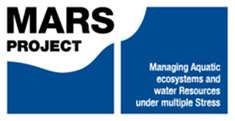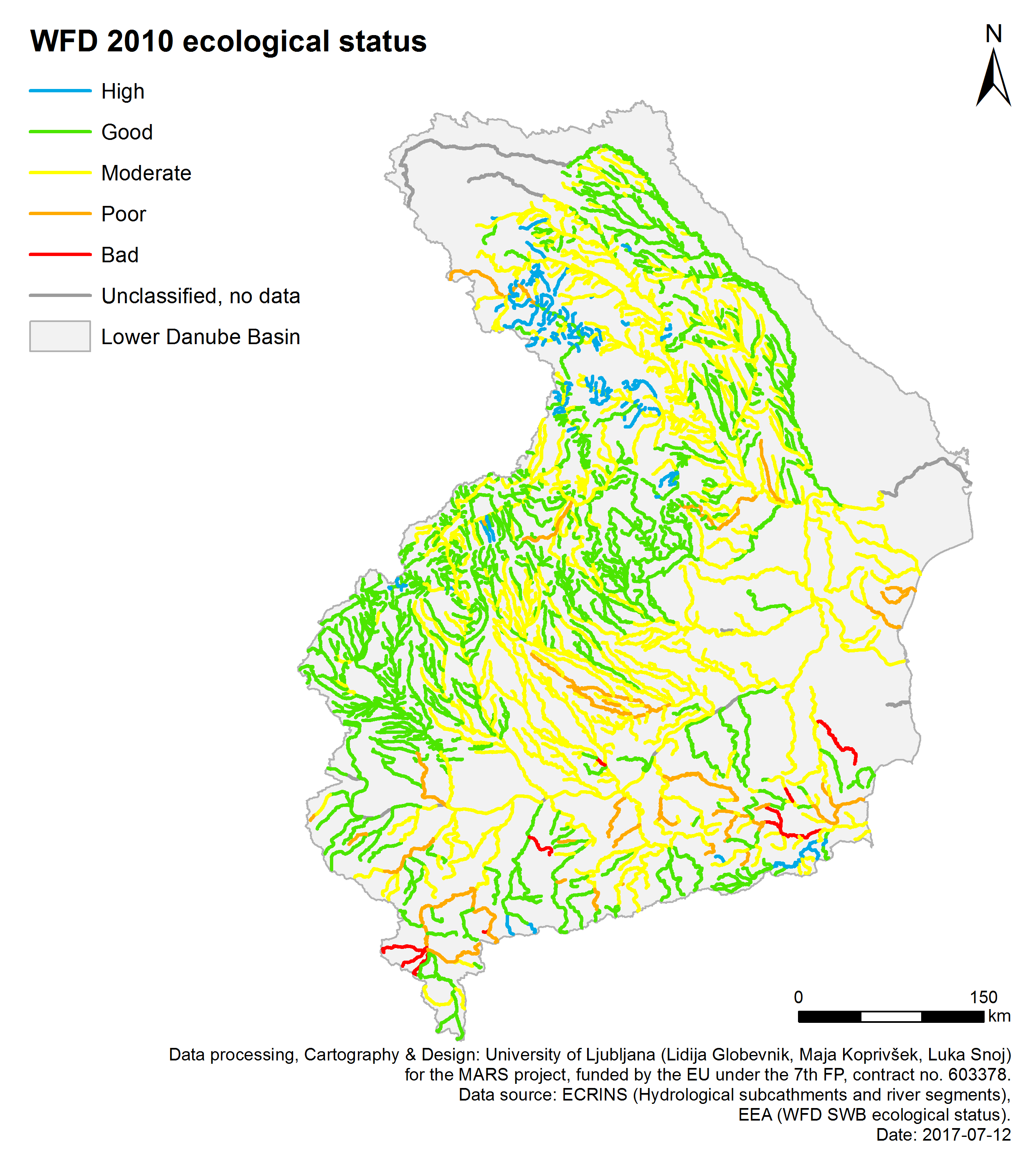Key findings
- The key pressures on fish populations in the Danube Delta are nutrient pollution and hydromorphological alterations.
- Fish population biomass in the Danube Delta is likely to continue to fall in coming decades, even under current land use and moderate climate change.
- Restoration of the Danube Delta floodplain through reconstructing natural drainage patterns, removing dams and embankments and limiting nutrient pollution may all help mitigate fish declines.
Water management issues
The Lower Danube Delta is impacted by four key drivers: agriculture, flood protection, transport and climate change. These cause pressures including hydromorphological alterations, point and diffuse pollution, dams, barriers and locks, flow diversions and hydrological alterations. The main pressures on Danube Delta ecological system are the construction of agriculture and fish polders and alterations to the hydrological regime as a result of upstream land reclamation, intensive agriculture, flood control and damming. Climate changes are increasingly causing hydrological, chemical and thermal stressors. Increases in temperature, evapotranspiration and decreases in the amount of precipitation contribute to seasonal water scarcity in the delta, despite increasing river water inflow into flood plain lakes through drainage channels.
As a result, lakes in the Danube Delta can suffer low water levels – particularly in late summer and early autumn – with resulting impacts on ecosystem status and service provision to humans. Low water levels reduce water exchange between lakes and the Danube river; can cause algae blooms and oxygen depletion; and expose fish to predatory birds, causing local outmigrations to more favourable habitats. Commercial fisheries are a key ecosystem service in the Danube Delta. As a result of the outlined pressures, historical fish catch data from 1960-2008 shows two trends: first a constant decline in fish catches, and; second, a change in fish populations from those favouring clear (mesotrophic) conditions, to those which can survive in turbid and algal (eutropic) conditions. In particular, populations of pike-perch (Sander lucioperca) and pike (Esox lucious) have significantly declined.
Environmental storylines and scenarios
The MARS study sought to quantify and analyse the impacts of water scarcity in the lake ecosystems of the Danube Delta on fish populations. This was undertaken using the MARS scenarios, which forecast environmental changes in the context of three storylines describing future political, economic, social and climatic changes, modelled to 2030 and 2060. Each scenario incorporates a different climate model based on Representative Concentration Pathways 4.5 or 8.5, modelling alterations to temperature, precipitation and wind. The scenarios were each quantified in terms of changes in nitrate and phosphorous loading, and water levels under future conditions. In Techno World, economic growth is prioritised and environmental management is typically ad hoc, and focused on instrumental gains such as flood and drought protection; climate change is significant (RCP 8.5). Nutrient loads will increase by 15% and 30% in 2030 and 2060 respectively. Nutrient loads will increase by 15% and 30% in 2030 and 2060 respectively. Consensus World has economic growth and environmental protections similar to present day; climate change is moderate (RCP 4.5). In the Lower Danube basin, nutrient loads are reduced by 7% (2030) and 15% (2060) compared to the present day. Fragmented World frames a global situation where countries have little regard for environmental protection; climate change is significant (RCP 8.5). Decreasing discharges of the Lower Danube result in hydrological stress and nutrient loads increase by 10% and 20% in 2030 and 2060 respectively. Whilst each scenario is a broad-scale approximation, their use in modelling provides a range of possible future trajectories to inform management and policy decisions.
Results and conclusions
Multi-stressor interactions
Fish populations are impacted by two key pressures: nutrient pollution and hydromorphological alteration. When water levels in the Danube delta lakes are low, total phosphorous, total nitrogen, total suspended solids and the residence time of water are the most important independent variables affecting fish biomass. Two pairwise stressor interactions were identified as significant (water residence time ratio X total phosphorus and water residence time ratio X total nitrogen) although the interaction type could not be defined.
Findings of scenario analysis
The results suggest that even if Consensus World conditions and moderate climate changes are maintained over the coming decades, fish population biomass in the Danube Delta is likely to continue to fall. In order to mitigate the effects of this trend on ecosystem status and service provision (particularly fisheries), a number of management initiatives may be undertaken. Restoration of the Danube Delta floodplain through reconstructing natural drainage patterns, removing dams and embankments and limiting nutrient pollution may all help mitigate fish declines.
Significance for water management
The results suggest that even if Consensus World conditions and moderate climate changes are maintained over the coming decades, fish population biomass in the Danube Delta is likely to continue to fall. In order to mitigate the effects of this trend on ecosystem status and service provision (particularly fisheries), a number of management initiatives may be undertaken. Restoration of the Danube Delta floodplain through reconstructing natural drainage patterns, removing dams and embankments and limiting nutrient pollution may all help mitigate fish declines.
Basin overview
The Lower Danube basin encompasses the river’s delta, where the main channel divides in three near the city of Tulcea. The Danube Delta in Romania covers an area of of 3,510 km2 and includes over 300 shallow floodplain lakes between 14-4530 ha with a water depth between 1.5-4 m. The lakes are supplied with river water through a vast network of 2800 km natural and artificial canals. Water levels depend on river flows, and are highest in spring (May-June) and lowest in autumn (August-October).
Context for modelling
Hydrological parameters such as water discharge, level and residence times were modelled using the Sobek Rural 1D2D software model, calibrated for the Delta. Ecological parameters such as precipitation, evapotranspiration and water temperature (abiotic) and chlorophyll-a, macrophyte vegetation and fish biomass (biotic) were simulated using the AQUATOX lake model. Statistical analysis combing the outputs of the two models to forecast changes to ecological status were undertaken using the Analytical Hierarchy Process (AHP), a a structured technique for decisions making, based on mathematics and psychology (Saaty, 2008). Boosted Regression Trees were used to discern the effects of parameters including nutrient levels, suspended sediments and residence time on fish biomass. The models contribute to a DPSIR (drivers, pressures, state, impact, response) model for the Danube Delta, in which the effects of different management interventions on ecosystem status and services (specifically, fisheries) are conceptualised.
Materials and methods
A data matrix was built to analyse the impact of hydromorphological and physico-chemical parameters on Danube Delta fish yields. The period analysed using the database was 1980 – 2010. The Danube Delta 1D2D hydraulic model (based on Sobek Rural software) was used to assess the water inflow, outflow and residence time in the lakes. AQUATOX software was used to model the lake ecosystems, and to simulate the MARS scenarios.
Facts and Figures: LOWER DANUBE
Further reading
MARS Deliverables:
MARS (2017). Case study Lower Danube - Case Study Synthesis - Deliverable 4.1. (Download report, 26.1mb)
Scientific articles and reports:
Buijse, A.D., Coops H. , Staras M. , Jans L.H., Van Geest G.J., Grift R.E. , Ibelings B.W. , Oosterberg W. & F.C.J.M. Roozen (2002). Restoration strategies for river floodplains along large lowland rivers in Europe. Freshwater Biology, Vol. 47, 889–907. DOI: 10.1046/j.1365-2427.2002.00915.x (Read abstract)
Grizzetti B., Lanzanova D., Liquete C., Reynaud A. & A.C. Cardoso (2016). Assessing water ecosystem services for water resource management. Environmental Science and Policy 61:194-203. DOI: 10.1016/j.envsci.2016.04.008 (Download article, 1.52mb)
Park A.R., Clough S.J. & Wellman C.M. (2008). AQUATOX: Modeling environmental fate and ecological effects in aquatic ecosystems, Ecological Modelling, Vol. 213, No. 1, pp. 1-15, DOI: 10.1016/j.ecolmodel.2008.01.015 (Read abstract)
Saaty, T.L. (2008). Decision making with the analytic hierarchy process, Int. J. Services Sciences, Vol. 1, No. 1, pp.83–98. DOI: 10.1504/IJSSCI.2008.017590 (Download article, 1mb)
Schiemer F., Guti G., Keckeis H. & Staras M. (2004). Ecological status and problems of the Danube River and its fish fauna: a review. In: Proceedings of the second symposium on the management of large rivers for fisheries, Vol I, Welcomme R. and T. Petr, Eds., FAO Regional Office for Asia and the Pacific, Bangkok, Thailand. RAP Publication 2004/16, pp. 273-279. (Download article, 1.09mb)
Additional documents:
Danube Watch (2017). The Magazine of the Danube River (1/2017) (Download report, 2mb)
ICPDR (2006). Danube Facts and Figures - Romania (Download flyer, 110kb )
ICPDR (2011). The Danube river and its basin (Download brochure, 6.55mb)
Websites:
Freshwaterblog (2010). Hungarian red sludge spill – three weeks later (External website)
Freshwaterblog (2013). Five things to do on Danube Day (External website)
Freshwaterblog (2014). Joint Danube Survey 3 Comes to a Close (External website)
Freshwaterblog (2014). Maps in Action: Situation and prioritisation of barriers along the Danube and its tributaries for restoration of longitudinal connectivity (External website)









